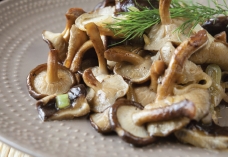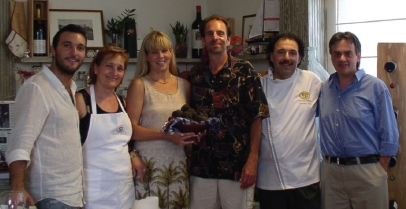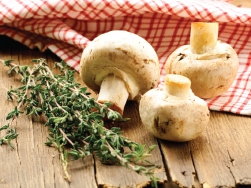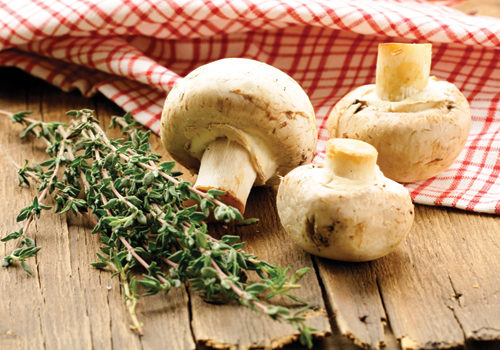The healthy, delicious and varied world of mushrooms is growing ever more popular, both in the natural and gourmet markets. With so many types to choose from, from fruity chanterelles, to meaty portobellos, to the most expensive truffles in the world, the mushroom market has something for everyone. This month, our Gourmet Guru, co-founder and owner of FungusAmongUs Lynn Monroe, talks with WholeFoods about the many benefits of mushrooms, both in culinary applications and in health.
FungusAmongUs was founded by Monroe and her husband, Michael, out of a love of mushrooms in a small Seattle garage in 1993. For the next 21 years, the company grew to provide the national market  with certified organic dried mushrooms and mushroom products such as truffle oils and soup mixes.
with certified organic dried mushrooms and mushroom products such as truffle oils and soup mixes.
WholeFoods: What do mushrooms and truffles bring to the table?
Monroe: Great earthy flavor(s) and texture as well as the healthy aspects. They are nutritional powerhouses. Many of them possess long histories for healing. They are also low fat, gluten free, low cholesterol and more.
WholeFoods: You’re right when you say mushrooms can heal! Full of antioxidants and vitamin D, they have anti-inflammatory properties, can support the cardiovascular and immune systems, brain health and much more. Readers can check out our February Supplement Highlights feature on Dementia for information on the benefits of lion’s mane, and for information on the myriad of benefits mushrooms provide, readers can turn to our Vitamin Connection, “The Health Benefits of Mushrooms: An Interview with Mushroom Expert Ken Babal,” by Dr. Richard A. Passwater, Ph.D.
Back in the kitchen, what are some ways inexperienced home cooks can easily incorporate dried mushrooms into their meals?

|
|
| Michael and Lynn Monroe, owners of FungusAmongUs, with the famous Italian truffle family, the Savinis. Gourmet Guru Lynn Monroe is holding an incredible truffle specimen. |
Monroe: Rehydrating mushrooms is easy. Simply soak them until they’re soft and reserve the liquid to use as stock. Mix and match whichever dried mushrooms you have on hand no matter what the dish calls for....in recipes, one type of mushroom can simply be replaced by another.
WholeFoods: Your Web site, www.fungusamongus.com, has great step-by-step soaking instructions; the mushrooms should be soft after soaking for about 30 minutes, and they should be rinsed and patted dry after the liquid is drained. I also see on your Web site information on many kinds of mushrooms; which types are best for which applications in the kitchen?
Monroe: Again, mix and match. One rule of thumb is that the stronger flavored mushrooms—like shiitake, porcini and truffle—will work better in stronger flavored dishes and the more subtle ones—such as oyster and crimini—will work in lighter flavored dishes.
WholeFoods: What are the advantages of using dried mushrooms versus fresh?
Monroe: Dried mushrooms have a much more concentrated flavor, which adds a lot to the complexity of the dish. Also, they are economical since you do not need as many as when you are using fresh mushrooms. The soaking liquid can and should be strained and reserved for use in the current or future dishes; it adds a wonderful flavor.
WholeFoods: Saving the liquid saves more than delicious flavor; according to mushroom expert Ken Babel in this month’s Vitamin Connection, the nutrients are extracted from the mushrooms and stay in the soaking liquid, so it’s best to use it for flavor and health!
 Do you see any upcoming trends in the mushroom market?
Do you see any upcoming trends in the mushroom market?
Monroe: Consumers are getting more educated about mushrooms and are trying more varieties. We get calls from stores all the time telling us that consumers are demanding varieties that used to be considered exotic.
WholeFoods: Interesting! Let’s say a retailer really only has enough shelf space for two or three types of mushrooms. Which types of gourmet mushrooms would you recommend he/she have in stock at all times and why?
Monroe: Always have porcini, shiitake and the FungusAmongUs Organic Medley, a mix of the most popular types. These are our top three sellers and the medley gives consumers the chance to try a number of mushrooms at one time. Morel is more expensive, but has a definite following and is in the top five sellers at our company.
WholeFoods: Morels are becoming very popular; there are even groups of people who go hunting for morels because they are absolutely delicious! Thank you for teaching us about gourmet mushrooms. WF
Published in WholeFoods Magazine, February 2014










